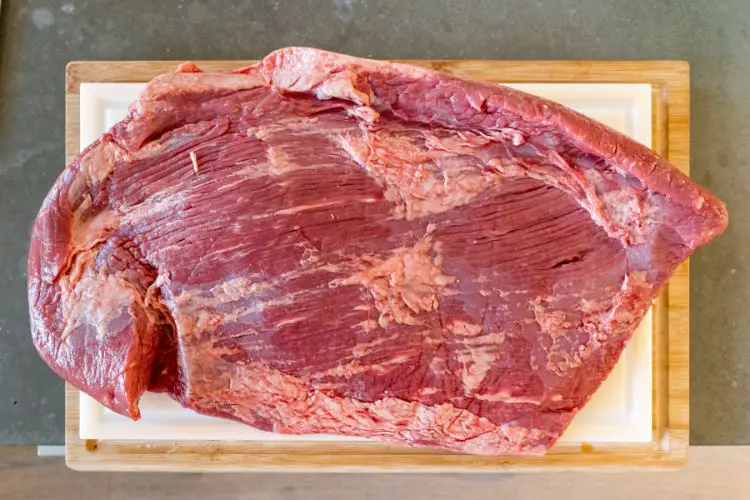Brisket stands out as a beloved beef cut, especially for barbecues and slow-cooked meals. If you’re planning to cook one, remember that starting with a frozen brisket means you need to thaw it right. Proper thawing isn’t just about convenience; it’s vital for taste and safety. Read guide and learn How to Defrost a Brisket, ensuring a delicious and safe meal every time. Let’s get started!
Why Proper Thawing Matters

When it comes to preparing meats like brisket, the thawing process is as critical as the cooking itself. Here’s why it’s essential to get it right:
Maintaining Meat Quality: Thawing brisket correctly preserves its natural texture, juiciness, and flavor. Hastily or unevenly thawed meat can become dry or tough when cooked. The fibers in the meat need to relax gradually to ensure they don’t lose their inherent moisture.
Safety First: Improper thawing can create a breeding ground for harmful bacteria. Meat that sits too long in the “danger zone” (between 40°F and 140°F or 4°C and 60°C) can allow bacteria like Salmonella and E.coli to multiply rapidly. By thawing brisket correctly, you significantly reduce the risk of foodborne illnesses.
Ensuring Even Cooking: A brisket that’s not properly thawed can lead to uneven cooking. The outer layers might become overcooked while the inside remains undercooked or even frozen. This not only impacts the flavor and texture but can also be a safety concern, as the inner parts might not reach the temperature needed to kill off harmful bacteria.
Optimal Taste: When you ensure your brisket thaws evenly and safely, it cooks more uniformly, leading to a better taste. The seasonings and marinades you apply can penetrate better, making every bite delicious.
Methods for Thawing Brisket
Thawing brisket correctly is the key to preserving its flavor, texture, and safety. Let’s delve deeper into the various methods to thaw your brisket, discussing each one’s nuances:
Refrigerator Thawing
Refrigerator thawing is one of the safest methods to defrost your brisket. Although it takes longer, this method ensures the meat remains at a safe temperature throughout the process. Here is how to do refrigerator thawing:
Preparation: Begin by placing the frozen brisket on a tray or in a shallow pan. This step prevents any potential drips from contaminating other items in your refrigerator.
Duration: As a rule of thumb, you should allocate about one day of thawing for every 5 pounds of brisket. So, for a 12-pound brisket, you’d need roughly 2.5 days to fully thaw it in the fridge.
Temperature: Ensure your refrigerator’s temperature is consistently at or below 40°F (4°C). This temperature range ensures the meat remains out of the bacterial “danger zone.”
Benefits: This is one of the safest methods to thaw meat, mainly because it keeps the brisket at a safe temperature throughout the process. Plus, it helps in retaining the meat’s moisture and quality.
Also Read: Decoding the Shelf Life: How Long is Rotisserie Chicken Good For?
Cold Water Thawing
Cold water thawing offers a quicker alternative to refrigerator thawing while still ensuring the brisket remains safe. Here are the guideline to do cold water thawing:
Packaging: First, ascertain that the brisket is in a watertight package. If the original packaging has holes or isn’t sealed, transfer the brisket to a leak-proof plastic bag.
Submersion: Fill a large container or sink with cold water and fully submerge the brisket.
Water Rotation: For optimal thawing, change the water every 30 minutes. This keeps the water cold, ensuring the meat doesn’t enter unsafe temperature ranges.
Duration: On average, a brisket will take about 30 minutes per pound to thaw using this method. Therefore, an 8-pound brisket would typically take about 4 hours.
Post-Thawing: Once thawed, it’s best to cook the brisket immediately, especially if you’re not sure how long it has been at room temperature.
Why is it not recommended to defrost large-cut brisket in a Microwave?
Defrosting a large-cut brisket in a microwave is generally not recommended due to several reasons, each of which can impact the quality, texture, and safety of the meat:
Uneven Thawing: Microwaves often heat unevenly, especially with larger cuts of meat. While some areas of the brisket might defrost quickly, others might remain frozen or even begin to cook. This results in an uneven texture when you eventually cook the meat.
Partial Cooking: The high power and uneven distribution of microwaves can lead to parts of the brisket starting to cook during the defrosting process. This partial cooking can change the meat’s texture, making it tougher or drier in certain areas.
Safety Concerns: Microwaving can bring parts of the brisket into the bacterial “danger zone” (between 40°F and 140°F, or 4°C and 60°C), while other sections remain cold. Bacteria thrive in the danger zone, which can increase the risk of foodborne illnesses.
Size and Shape Limitations: Many briskets, especially full cuts, are too large to fit comfortably in a standard microwave. Even if they do fit, their irregular shape can exacerbate the uneven thawing issue.
Loss of Juices: Microwaving can cause the brisket to lose more of its natural juices compared to gentler thawing methods. As these juices are lost, the meat can become drier, and flavors can be compromised.
What not to do when thawing brisket
Thawing brisket properly is not just about knowing the right methods but also being aware of the common pitfalls. Making mistakes in this initial step can compromise the flavor, texture, and safety of your meal. Here’s what you should avoid:
Thawing at Room Temperature:
Never leave your brisket out at room temperature to thaw. This method can make the outer parts of the brisket reach a temperature that’s ideal for bacteria to grow, even while the inside remains frozen.
Using Hot Water:
Avoid the temptation to use hot water to speed up the thawing process. Just like leaving it out on the counter, hot water can cause the outer layers of the brisket to enter the bacterial “danger zone” while the inside is still frozen.
Refreezing Without Cooking:
If you’ve already thawed your brisket, don’t refreeze it unless you’ve cooked it first. Refreezing thawed meat can degrade its texture and flavor. Plus, it’s risky in terms of potential bacterial growth.
Microwaving Large Cuts:
While microwaving might seem fast and efficient, it’s not suitable for large cuts like brisket. Microwaves can heat unevenly, leading to parts of the meat getting cooked while other areas remain frozen.
Tips for Thawing Brisket
Properly thawing brisket is an essential step in ensuring a flavorful, tender, and safe meal. To make the most of your brisket experience, consider the following tips:
Plan Ahead: Always remember that brisket, especially larger cuts, can take considerable time to thaw, especially in the refrigerator. Depending on the method and the size of the brisket, you might need to allow anywhere from several hours to multiple days for complete thawing.
Check the Packaging: Before you start thawing, inspect the packaging. Ensure it’s intact and free from holes or tears, which could allow bacteria to enter or juices to leak out.
Use a Drip Tray: Whether thawing in the fridge or elsewhere, always place the brisket on a tray or in a shallow pan. This will catch any juices that might escape, preventing cross-contamination in your fridge or workspace.
Maintain Cold Water: If using the cold water thawing method, ensure the water stays cold throughout the process. Changing the water every 30 minutes will help maintain a consistent cold temperature.
Avoid Refreezing: Once thawed, avoid refreezing the brisket unless you’ve cooked it first. Thawing and refreezing can compromise the meat’s texture and increase the potential for bacterial growth.
Use a Meat Thermometer: When using faster thawing methods, it’s wise to use a meat thermometer to check the temperature of various parts of the brisket, ensuring none of it reaches the danger zone.
Consider Partial Thawing for Trimming: If you plan to trim your brisket, consider doing it when the meat is partially thawed. Semi-frozen meat can be easier to handle and cut, especially when removing fat or silver skin.
Clean Up Thoroughly: After thawing, always clean and sanitize any surfaces the brisket or its juices have touched. This step ensures a hygienic cooking environment and helps prevent cross-contamination.
Reasons why brisket take so long to defrost?
Brisket is a large and dense cut of meat, and its size plays a major role in its lengthy defrosting time. When thawing meat, the process is gradual, moving from the outermost layers inwards. Due to the thickness and size of brisket, it takes a while for the innermost parts to defrost fully.
Additionally, the method of thawing can also influence the time. Refrigerator thawing, for example, is a slow process. The fridge maintains a consistent cold temperature, usually below 40°F or 4°C. This temperature ensures the meat remains safe from harmful bacteria, but it also means the thawing process isn’t rapid.
Another reason is the importance of safety. Thawing brisket too quickly, especially by unsuitable methods, can lead to uneven defrosting. The outer layers might reach temperatures where bacteria grow rapidly, while the inside remains frozen. Slow, controlled thawing ensures the entire brisket defrosts evenly and safely.
FAQs
Can I cook my brisket without thawing it?
While it is possible to cook from frozen, it’s not recommended. Cooking a frozen or partially frozen brisket can lead to uneven cooking, with the risk of the outer layers being overcooked while the inside remains undercooked.
Is there a way to speed up the thawing process?
Yes, the cold water thawing method is quicker than refrigerator thawing. By submerging the brisket in cold water and changing the water every 30 minutes, you can expect it to thaw at a rate of about 30 minutes per pound.
Why can’t I just leave my brisket out on the counter to thaw?
Thawing brisket at room temperature can cause the outer layers to enter the bacterial “danger zone” long before the inner part thaws, increasing the risk of foodborne illnesses.
How can I tell if my thawed brisket has gone bad?
Spoiled meat often has a sour or off smell. The surface may also feel slimy, or the color may have turned grayish. If any of these signs are present, it’s best to discard the meat.
If I thaw my brisket in the refrigerator, how long can I keep it before cooking?
Once fully thawed in the fridge, a brisket should be cooked within 3-5 days to ensure freshness and safety.
Can I refreeze my thawed brisket?
Refreezing thawed meat can degrade its quality and texture. If you must refreeze, it’s better to cook the brisket first and then freeze the cooked leftovers.
Are there any health risks associated with improper thawing?
Yes, improper thawing can allow harmful bacteria like Salmonella and E.coli to multiply rapidly, increasing the risk of foodborne illnesses.
Conclusion
You’ve learned the ins and outs of thawing brisket. Always remember the key points: prioritize safety, plan ahead, and choose the right thawing method for your needs. Avoid shortcuts that might compromise the quality or safety of your meat. When you take the time to thaw your brisket correctly, you set the stage for a delicious and tender meal. Now, armed with this knowledge, you’re ready to prepare that perfect brisket dish. Enjoy your cooking journey!

